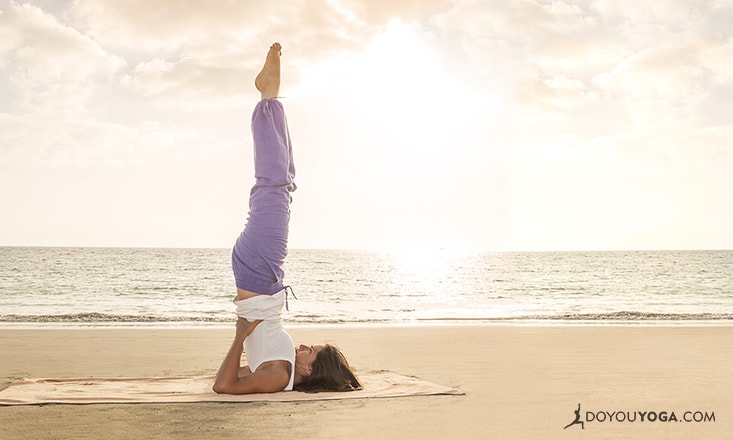I was in one of my first “real” yoga classes after years of practicing in a gym setting. It was the end of class and my teacher cued Shoulderstand, one final inversion before Savasana. I looked around the room, thought, “I can do that,” and I did. It’s only in hindsight that I know that I wasn’t yet ready for this powerful pose. Many yogis swear by Shoulderstand, but it is has also been noted as one of the riskiest yoga poses. Utilizing modifications, choosing alternatives and using the breath as a guide will help you to protect the precious and delicate bones in your neck from injury.
The path of yoga calls upon us to practice discernment (viveka in Sanskrit), both on and off the mat. We are asked to not only choose, but to choose wisely. All of our postures, from Mountain Pose to Savasana to Shoulderstand should be practiced with an open heart and a keen mind. Just because we can do something, doesn’t mean that we necessarily should.
How to Keep Your Neck Safe in Shoulderstand
Read on for 5 ways to modify Shoulderstand to gain the utmost benefit from the pose with the least risk to your neck. Remember, inversions are contraindicated for anyone with uncontrolled blood pressure or glaucoma.
1. Try a Block
 Credit: Kaisa Kapaten
Credit: Kaisa Kapaten Using a block is a mindful way to modify your Shoulderstand. Lie on your back with your knees bent. Settle the soles of your feet evenly into the ground. Lift your bottom and place a block (on its lowest height to begin) beneath your sacrum (the triangular space below your lower back and above your tailbone), about even with the waistband of your pants. Gently lift one leg into the air and then the next. The block should feel like it’s completely and safely supporting your lower body (the sacrum is a flat surface of fused bones). If not, bring your feet to the ground and adjust the block. Your hands can remain by your sides, with palms up if you are seeking energy and palms down if you’d like to ground and center. If the low setting of your block feels okay, you can eventually shift to the medium or high setting, taking care to monitor your upper back and neck for any pain or discomfort. As with all postures, listen to your body, lowering or removing the block as needed.
2. Go Spidey Style
The wall is often overlooked as a useful prop in yoga classes. Never be afraid to get up and move your mat to make use of this great resource. To modify Shoulderstand using the wall, channel your inner Spiderman. Come to your back with your legs up the wall. This is also a great inversion option if you’d like to stay right here. To proceed into a Shoulderstand variation, begin to walk your feet up the wall, keeping your knees bent. Release your elbows to the mat and bring your hands to your lower back for support. As you gain confidence in this pose and learn whether it’s right for your body, you can play with lifting one leg off the wall at a time. Notice that as your legs move up the wall the pressure on your neck increases. Be mindful and take your time. Sometimes the most powerful practice is in choosing the gentlest option.
3. Soften with Blankets
Place three square-fold blankets on the ground. Lie down with your back and shoulders on the blankets, allowing your head and neck to come off the blankets to the mat below. Place your elbows beneath you and begin to draw your knees toward your chest. Allow your hands to come to your lower back for balance and support. You can play with lifting one or both legs toward the sky as you progress in this pose. The blankets will provide a cushion and decrease the intensity of your weight on your neck.
4. Be a Bug
 Credit: lisagulotta.com
Credit: lisagulotta.com If none of these Shoulderstand modifications work for you, bugging out can actually be a good thing. Bug pose is a safe alternative to Shoulderstand. Begin on your back with your knees bent and the soles of your feet on the ground. Lift both feet into the air, keeping your neck, back and torso on the ground. If this feels okay, lift your arms toward the sky too. I often encourage my students to make this a playful moment in their practice. Twirl your ankles. Wiggle your fingers. Bend your knees. Spread your legs into a wide straddle. Eventually, you might wish to settle into stillness and allow the power of the inversion to restore and renew you. Remain here for as long as the posture serves you.
5. Use the Breath
No matter which expression of Shoulderstand you choose, use the breath to guide your practice and to help you determine where modifications are warranted. Pain is not the only indicator that you’ve blown past your boundaries. If you lose your breath practice, that’s often a good sign that you aren’t ready for or aren’t built for that expression of the pose.
Shoulderstand is not for everyone and many teachers advise against it due to the risk of injury. Again, our jobs as students and teachers is to practice viveka, discerning what serves our highest good in body, mind and spirit.






